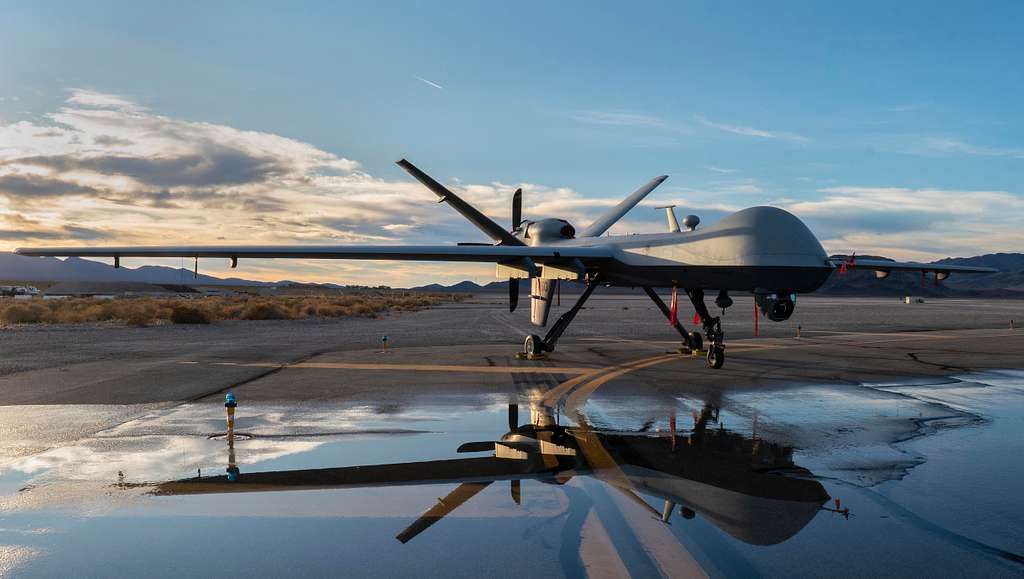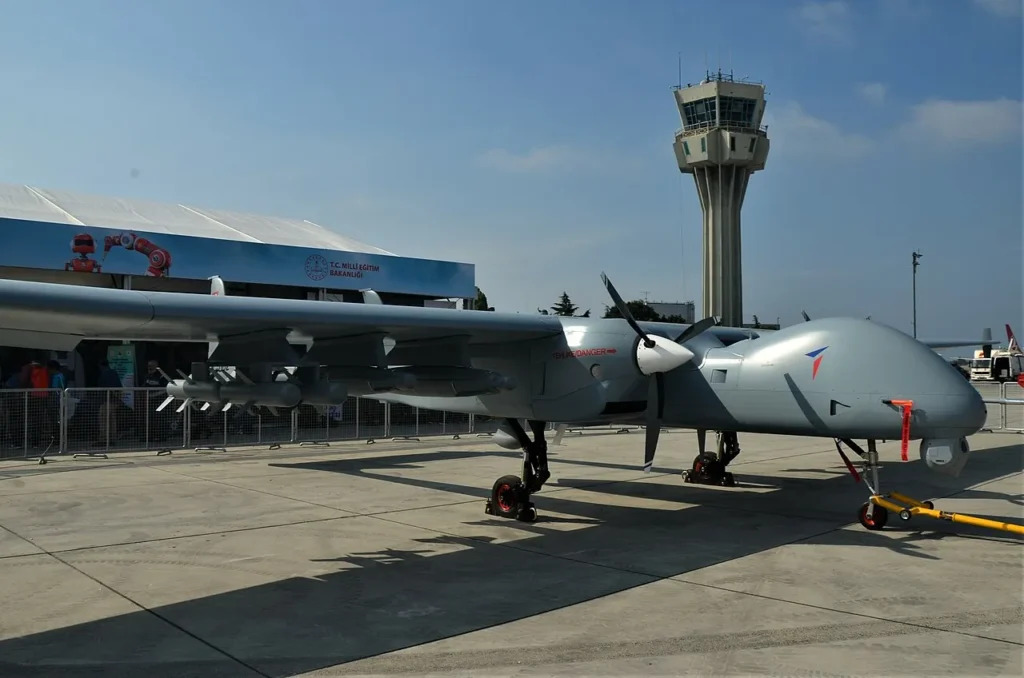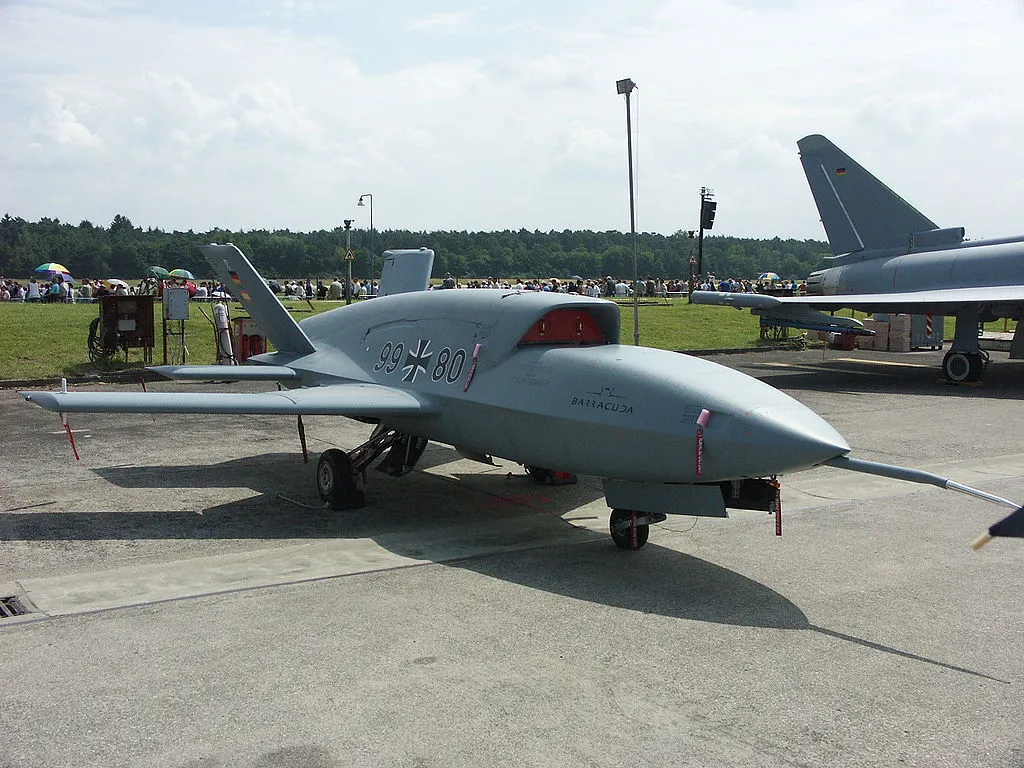
Gone are the days when warfare meant sending pilots into harm’s way for every reconnaissance mission or precision strike.
Today’s military landscape is dominated by sophisticated unmanned aerial vehicles that can stay airborne longer than any human pilot could endure, strike with pinpoint accuracy, and gather intelligence without risking precious lives.
 MQ-9B drones from the US; Photo: picryl
MQ-9B drones from the US; Photo: picrylMost Dangerous Drones in the World
These mechanical marvels have transformed from simple surveillance tools into the backbone of modern military operations.
And speaking of recent conflicts, the India-Pakistan tensions have seen their fair share of drone incidents, with both nations increasingly relying on unmanned systems for border surveillance and tactical operations.
Let’s dive into the 10 most impressive flying robots currently ruling the skies!
1. MQ-9 Reaper (United States)
 An MQ-9 Reaper is parked on a taxiway during sunset | Photo: picryl
An MQ-9 Reaper is parked on a taxiway during sunset | Photo: picrylThe grandmaster of combat drones, General Atomics’ MQ-9 Reaper, has been the gold standard since its introduction in the early 2000s.
This beast can soar up to 50,000 feet and stay airborne for over 27 hours – that’s longer than most people spend awake in a day.
With a payload capacity of 3,800 pounds, it can carry everything from AGM-114 Hellfire missiles to GBU-12 Paveway II bombs.
The Multi-Spectral Targeting System provides crystal-clear imagery that would make any photographer jealous. The Reaper has seen action across the Middle East and Africa, serving as both a watchful eye and a precise hammer when needed.
2. RQ-4 Global Hawk (United States)
 RQ-4 Global Hawk; Photo- Wikipedia
RQ-4 Global Hawk; Photo- WikipediaNorthrop Grumman’s RQ-4 Global Hawk is essentially a high-tech spy satellite that happens to fly in Earth’s atmosphere.
Operating at altitudes exceeding 60,000 feet, this surveillance champion can remain airborne for over 30 hours, covering enormous territories in a single mission.
Its sophisticated sensor suite includes synthetic aperture radar and electro-optical systems that work in any weather condition.
The Global Hawk has proven invaluable for everything from battlefield surveillance to disaster response, making it the ultimate eye in the sky.
3. Bayraktar TB2 (Turkey)
 Bayraktar TB2, Turkey; Photo- Wikipedia
Bayraktar TB2, Turkey; Photo- WikipediaTurkey’s Bayraktar TB2 has become something of a celebrity in the drone world, earning recognition for its effectiveness and surprisingly affordable price tag.
This medium-altitude workhorse can fly at 27,000 feet for 27 hours, carrying up to 150 kilograms of munitions like MAM-L and MAM-C precision strikes.
Its triple-redundant avionics system makes it remarkably resilient against electronic warfare. The TB2 has proven its worth in conflicts across Syria, Libya, and Nagorno-Karabakh, consistently punching above its weight class.
4. CH-5 Rainbow (China)
 CH-5 Rainbow, China; Photo- Wikipedia
CH-5 Rainbow, China; Photo- WikipediaChina’s CH-5 Rainbow represents the nation’s serious entry into the advanced UAV market. With an impressive 60-hour endurance and 30,000-foot service ceiling, it’s built for the long haul.
The drone can carry up to 1,000 kilograms of weaponry, from air-to-surface missiles to guided bombs. Its advanced electro-optical and infrared sensors provide exceptional targeting capabilities, making it a formidable competitor to Western designs.
Several countries have already added the CH-5 to their arsenals for border surveillance and counterinsurgency operations.
5. Hermes 900 (Israel)
 Hermes 900 (Israel); Photo- Wikipedia
Hermes 900 (Israel); Photo- WikipediaIsrael’s Elbit Systems created the Hermes 900 as a versatile platform that excels in multiple roles. Operating at altitudes up to 30,000 feet with over 36 hours of endurance, it can carry 350 kilograms of sensors and equipment.
The drone features synthetic aperture radar and maritime patrol capabilities, making it equally at home monitoring illegal fishing activities or supporting disaster relief efforts.
Its advanced avionics and autonomous flight capabilities significantly reduce operator workload.
6. S-70 Okhotnik (Russia)
 S-70 Okhotnik (Russia); Photo- DeviantArt
S-70 Okhotnik (Russia); Photo- DeviantArtRussia’s S-70 Okhotnik, or “Hunter,” is a next-generation stealth drone that looks like it flew straight out of a science fiction movie.
Built by Sukhoi with a flying-wing design similar to the B-2 Spirit bomber, it’s designed to evade radar detection. With a 6,000-kilometre range and speeds approaching 1,000 km/h, it’s built for deep-strike missions.
The Okhotnik is designed to work alongside Russia’s Su-57 fighter jets in a “loyal wingman” configuration, extending reconnaissance and attack capabilities. While still in development, it’s expected to be fully operational by 2025.
7. TAI Aksungur (Turkey)
 TAI Aksungur (Turkey); Photo- Wikipedia
TAI Aksungur (Turkey); Photo- WikipediaTurkish Aerospace Industries’ twin-engine Aksungur is another impressive entry from Turkey. This marathon flyer can stay airborne for over 49 hours at 40,000 feet, making it one of the most persistent drones available.
With a 750-kilogram payload capacity, it can carry MAM-L smart munitions and Roketsan SOM missiles.
Its advanced electro-optical systems and synthetic aperture radar make it particularly effective for maritime operations. Satellite communication capability extends its operational reach far beyond traditional line-of-sight limits.
8. Wing Loong II (China)
 Wing Loong II (China); Photo- Wikipedia
Wing Loong II (China); Photo- WikipediaChengdu Aircraft Industry Group’s Wing Loong II serves as China’s answer to the American MQ-9 Reaper. Flying at 30,000 feet for over 20 hours, it can carry 12 air-to-ground munitions, including precision-guided bombs and anti-tank missiles.
The drone features AI-enhanced operations that allow for autonomous missions with minimal human oversight.
The Wing Loong II has seen extensive use in Middle Eastern conflicts and continues to showcase China’s growing influence in military drone technology.
9. EADS Barracuda (Germany & Spain)
 EADS Barracuda; Photo- Wikipedia
EADS Barracuda; Photo- WikipediaAirbus Defence and Space’s Barracuda represents Europe’s entry into the stealth drone arena. Using low-observable technology to reduce radar signatures, it’s designed for deep-strike missions in contested airspace.
The drone can reach speeds of 1,000 km/h with an operational range exceeding 3,000 kilometres.
Its network-centric warfare capabilities allow it to operate in swarms and communicate with fighter jets, improving overall battlefield coordination. While still in testing phases, it’s expected to become a cornerstone of European defence strategies.
10. Kratos XQ-58A Valkyrie (United States)
 Kratos XQ-58A Valkyrie; Photo- Wikipedia
Kratos XQ-58A Valkyrie; Photo- WikipediaThe experimental XQ-58A Valkyrie represents the future of cost-effective drone warfare. Developed under the U.S. Air Force’s Low-Cost Attritable Aircraft Technology program, it’s designed as a “loyal wingman” for fighter jets.
Using artificial intelligence for autonomous operations, it can fly at Mach 0.85 with a range exceeding 3,000 kilometres.
Its internal weapons bay can carry both air-to-air and air-to-ground missiles, significantly supplementing traditional aircraft capabilities at a fraction of the cost.
Bottom Line
As we survey this impressive lineup of flying machines, it’s clear that warfare has entered a new chapter where robots do the heavy lifting while humans make the big decisions from the safety of air-conditioned control rooms.
These technological marvels have transformed military operations from risky human endeavours into precise, calculated chess moves.
With artificial intelligence becoming smarter, weapons becoming more accurate, and endurance reaching superhuman levels, future conflicts might look more like elaborate video games than traditional battles. The only question remaining is whether future history books will be written by humans or by the very drones they created!
Stay tuned with us. Further, follow us on social media for the latest updates.
Join us on Telegram Group for the Latest Aviation Updates. Subsequently, follow us on Google News
Top 5 Fastest Spacecraft Ever Built in the World
The post Most Dangerous Drones in the World in 2025, No.4 Will Surprise You appeared first on Aviation A2Z.









![A gdyby tak rzucić wszystko i wyjechać do Maroka… [zdjęcia]](https://tarnow.ikc.pl/wp-content/uploads/2025/10/ucieczka-do-tangeru-fot.-Artur-Gawle0001.jpg)



